It’s become an annual tradition here to look at the finances of Team Sky/Ineos and Ag2r La Mondiale. Why? Because they’ve been the only teams to file accounts.
Team budgets matter but data are hard to come by. Some of the estimates doing the rounds in recent years are so dubious they’ve managed to get the numbers that have been audited and published wrong. Here’s a closer look at the published accounts and money behind the brown short brigade…
Ag2r La Mondiale? It’s a French social insurer, people and companies can take out pension plans, life insurance, pet cover and other savings. It’s a mutual where policy holders own the business and is one of France’s largest insurers. It was going to become even bigger with a merger with Matmut, another French mutual, a subject reported on here the last time we looked at the team’s finances but the merger was stopped at the last minute with executives citing “a difference in values”, the corporate version of a bride or groom doing a runner from the altar in their wedding garb. The firm has been a sponsor of the team since 1998, first as a co-sponsor for two years and then it’s been Ag2r La Mondiale since 2000.
The team’s 2018 season was a decent one but not stellar, Romain Bardet was second on the Strade Bianche and sixth in the Tour de France, Oliver Naesen won the Bretagne Classic, Silvan Dillier was second in Paris-Roubaix, Alex Geniez and Tony Gallopin took a stage of the Vuelta each.

That’s a screengrab of the public filing of the accounts and you can see the budget for 2018 is €17,608,614. Again it’s for the year ending 2018 and not last season, once a year has ended the numbers are crunched, audited, accounts prepared and reviewed and then filed with a court clerk in the Alpine town of Chambéry where the team has its HQ and this all takes time… and a reader kindly sends them over, merci. The grab above shows the revenue received but there’s little breakdown, just €238k for “sales of goods”, an end of season sale of bikes comes to mind but for this team the old team bikes are often hand-me-downs for their development squad. The other line of €17.3 million is sponsorship in total but also other income teams get like participation fees from race organisers and so on.

You can see the spend for 2018 was €18.1 million but for consistency here the headline budget is the revenue, the money flowing in but be aware of both figures. There’s a loss for 2018 of half a million Euros but this is covered from reserves; there was a profit of about the same amount the previous year and the aim is this balances over the years. The entire wage bill for the team is €9.150 million on top of which is added €2.93 million of “social charges”, French jargon for payroll taxes. Unlike some other countries and teams, French riders are hired as employees and French payroll taxes, some of the highest in the world, apply. This makes it harder for French teams to recruit a star rider, someone on the market for say, €1 million will take €1.3 million out of a French team’s budget. It’s a reminder that talk of budget and salary caps are easier said than done. The gross wage bill is €12.1 million, roughly 70% of the team budget. Among the other lines of expenditure is €632k on “raw materials” which presumably includes fuel for the team vehicles, travel expenses but it’s hard to know where this stops and things like training camps and other expenses begin.
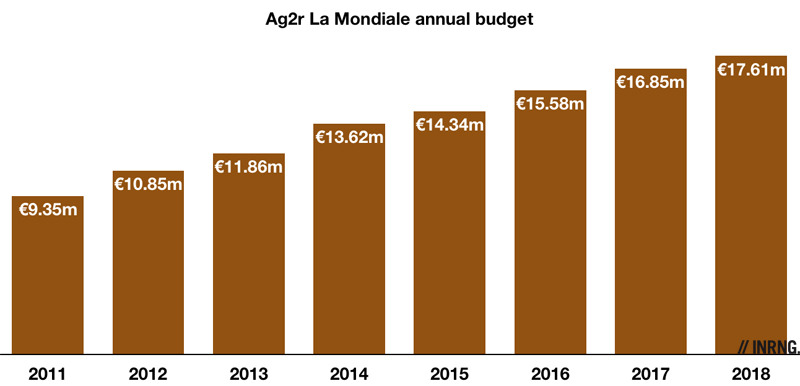
As this team publishes the accounts annually we can trace the budget over recent years and the chart above shows a compound growth rate of 9.4%. You can see the growth rate is slowing, the increase on 2017 was 4%, the smallest annual percentage increase. There were few roster changes but big name Domenico Pozzovivo left and Silvan Dillier joined but we’ll come to a financial hit in a minute.
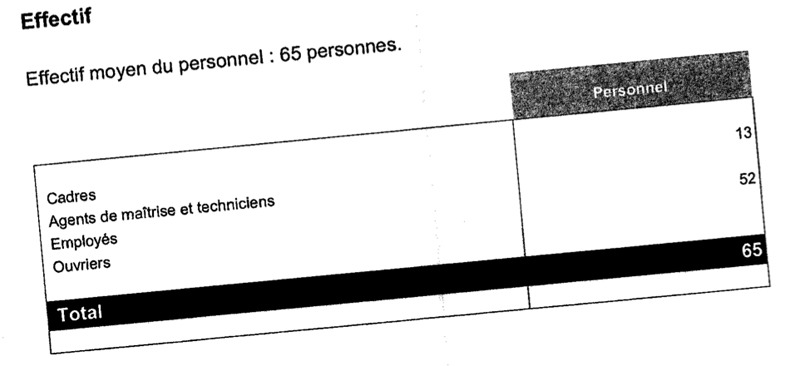
This grab shows the number of staff on the books: 65, with 13 managers and 52 employees. It’s normal for teams to have more staff than riders but rare to see the count in black and white. Some teams hire in help on a more contractual basis, eg a soigneur or mechanic can be hired for a weekend.
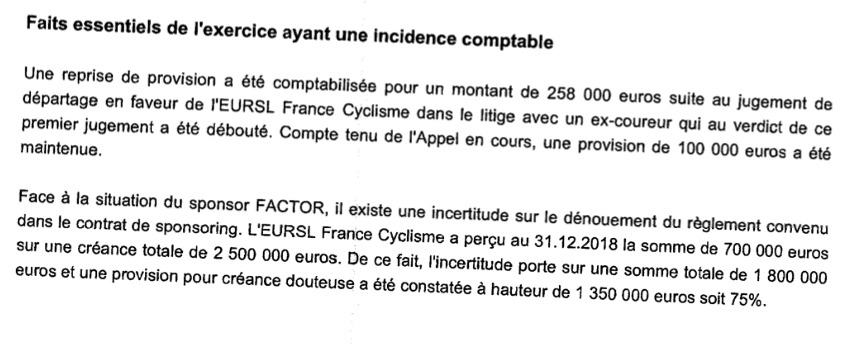
The accounts have notes with provisions for two one-off events. First is a court case with an ex-rider where the team has been awarded €258,000 but it’s gone to appeal so for now only €100,000 is recorded in the accounts (your guess is as good as any but one possibility could be Lloyd Mondory who was caught for EPO in 2015 and the case has taken its time). Next is the matter with Factor bikes, they were sponsoring the team but as L’Equipe has reported, the manufacturer “couldn’t meet its financial commitments” to the team and so the deal ended. Here the notes say “there is uncertainty over the outcome of the settlement in the sponsorship contract” and that the team banked €700,000 on 31 December 2018 but the promised sum was €2.5 million, leaving €1.8 million outstanding and the team books a hefty charge €1.35 million as a bad debt. This explains plenty like the sudden switch to Merckx and Ridley and the team’s concerns over its equipment, it’s not just been a technical choice of material but a substantial sum of money they’ve been missing.
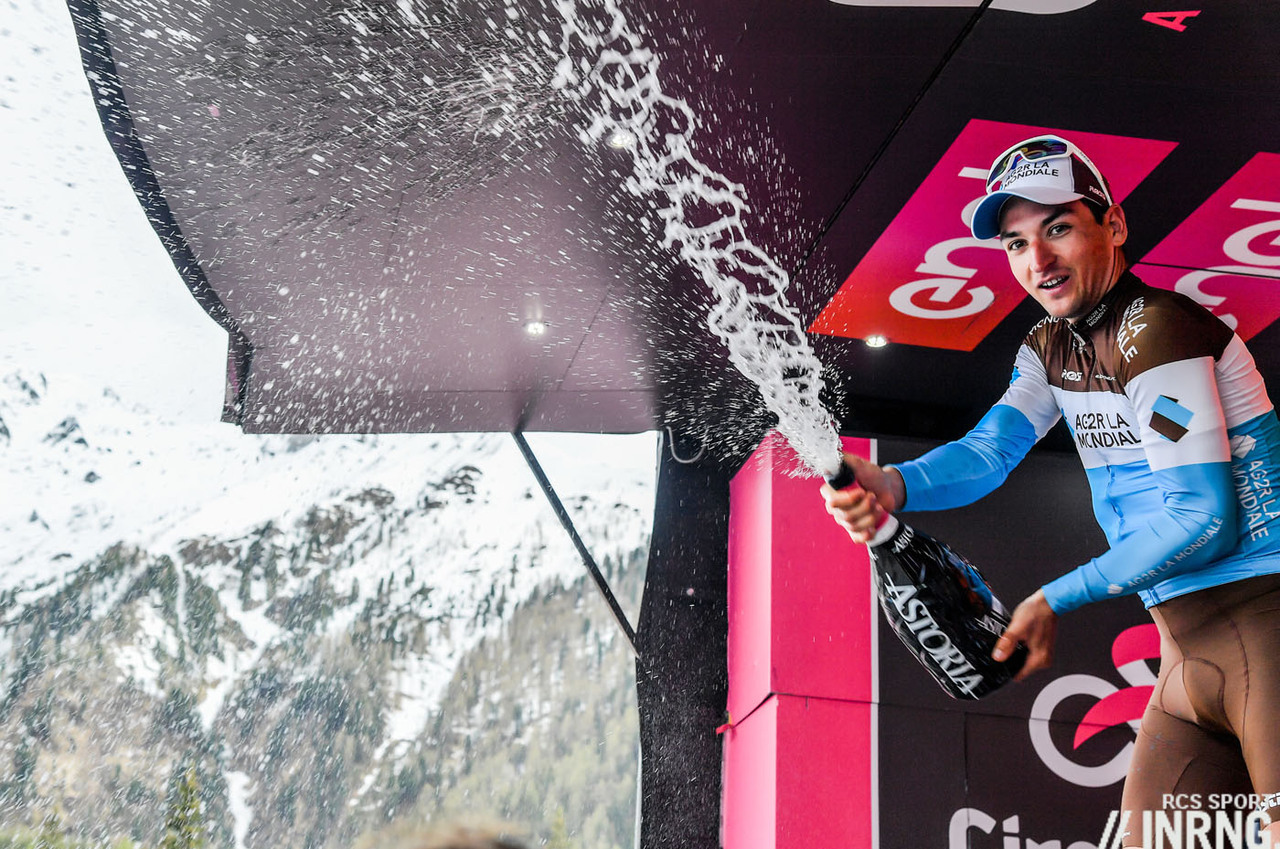
Conclusion
It’s dry but money makes the wheels go round and the mention of the court case against an ex-rider and the sum for the Factor sponsorship in black and white is spicy. 2018 saw an increase again but only a small one and it’ll be interesting to see what happened for 2019 given the shortfall from Factor but this is against a stable roster of riders, the team hasn’t made any big signings. It has its own development team in Chambéry Cyclisme Formation which has provided a steady pipeline of talent like Bardet, Latour, Peters, Cosnefroy and more, to the point where they produce a surplus, they wanted to promote American Matteo Jorgenson to the pro team but in a year’s time only he went to Movistar instead. Looking ahead the squad has 18 riders with their contracts up for renewal at the end of the year including leaders Oliver Naesen and Romain Bardet which is a big financial challenge to square in the best of times but the sponsor has extended their backing until the end of 2023.
- Exchange rates at 31 December 2018: €1 = US$ 1.14 = AU$1.63 = £0.89 GBP

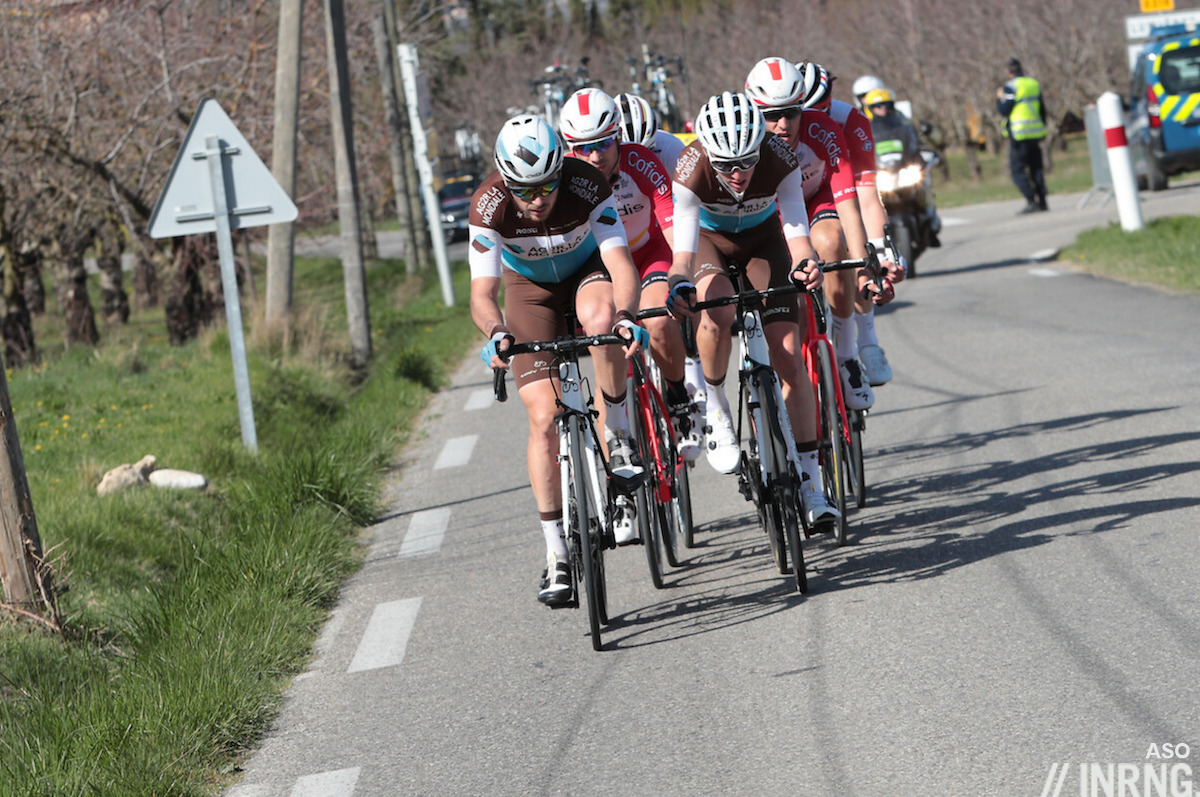
Thanks for taking the time to analyse this. Too many teams appear to run in dark corners. One reason why sponsorship caps will never work.
As an aside INEOS are constructing/converting two factories, one in Germany and one in GB, within the next 10 days, to manufacture one million had sanitises a month free for the Health Industry . INEOS some times take a little stick, but they are also a company with a social conscience.
Budget and salary caps are difficult, as we’ve seen in other sports this year various caps and fair play initiatives can become something to be gamed and typically the biggest, richest squads are able to hire the lawyers to find the sneakiest loopholes. Plus they’d be something that the UCI would struggle to audit, teams would end up paying a lot for this.
As for Ineos they’ve also got two factories in Germany which have been going “flat out” according to news reports. There have been fears of a shortage of isopropyl alcohol, the main ingredient of the hand rub but such is the demand even grappa distilleries in Italy and so on are helping. Soap and water works as well but not everyone can use it all the time, eg a bus driver or a supermarket cashier.
It’s also worth remembering that salary caps can easily become a mechanism for wage suppression across the peloton. Who sets the cap? It’d be uncharted territory for a body like the UCI. And if it’s the teams / ASO / RCS, what incentive is there to *not* set the cap low?
If you think sports like American football can be a model here, then remember that the salary cap in the NFL is collectively bargained between the NFL and the player’s union. The team cap is effectively set as a % of the league’s total revenue, divided by 32 (the total number of teams). The players have gone on strike before to get a bigger slice of the pie. This all works fine when you have one employer (the NFL) and one union of employees (the NFLPA). Cycling has just about the opposite – a total mess of teams, riders, and race organisers, with (as we know all too well) a remarkable lack of central organisation.
As someone who is staunchly pro-labour in all walks of life, I just can’t see how a salary cap would work in cycling without it being to the detriment of the riders. It might seem unfair that Chris Froome gets so much more money than Nic Dlamini; but I’m not at all convinced a cap on Froome’s salary would translate to more money for Dlamini. It’d just leave more money in Jim Ratcliffe’s pocket.
The 10% long-term annual growth rate of team budgets is in line with my earlier findings for Belgian teams over the past 30 to 40 years. It is difficult to determine what would justify such a strong yearly growth. Long-term inflation is just 2-3% and it is not the case that road cycling as a “product” becomes more valuable at a rate of 10% on a yearly basis (in contrast to some other sports like e.g. football). But it does mean that team managers year after year after year had to ask for 10% more …
I’d guess that a large part of that 10% increase in team budgets can be attributed to wage inflation?
And one might argue about the worth of the cycling ‘product’ but I’d point out that it’s more about the worth of elite athletes particularly relative to other sports.
In that regard, cycling is ridiculously good value?
Anecdotally there was a pinch point when Tinkov and Alonso were coming into the sport, eg Nacer Bouhanni got a contract worth over a million Euros a year (he was winning multiple Giro and Vuelta stages) and prices for riders like Sagan and Kwiatkowski soared. So is it the arrival of richer men coming into the sport and bidding up the prices for riders?
I imagine another reason for the budget increases is that teams have had to raise their game and become more professional, e.g. hiring more scientific advisers, public relations staff, etc.
Apropos, there’s a small typo in the paragraph about staff, with ’employer’ where presumably ’employee’ is meant.
True, this has changed and in the wake of the Astana mess of them also losing their licences all teams have to have trainers and support staff for their riders and more. Before this it was common for riders to be coached by someone outside the team.
One only has to read about the various means that the English rugby union team Saracens used to pay some of their players “outside” the agreed salary cap to appreciate how inventive some teams and owners become to secure success.
This resulted in a £5miliion+ fine, points deduction and thus guaranteed relegation next season.
This after several years of success in national and european competition has meant the dismantling of the team with players departing to pastures new, but at what new income levels?
What the Saracens example may also demonstrate is that direct payments to athletes / staff that do not come via the team’s accounts may not necessarily show up on them either?
For instance, if Peter Sagan is paid directly from Specialized’s sponsorship would this show up on Bora’s annual accounts? I suspect not.
If this is the case, the comparison between teams’ budgets doesn’t tell the full tale.
Equity is not what sport is about, surely? Fairness is probably more important.
If a sponsor wants to put in big money, that’s up to them and it means the team can attract the marquee names who happen to bring better results. Structures are different across the teams, too. Ineos owns the team, whilst most others trade as their own entity able to supply naming rights to sponsors. Riders can be employees like in AG2R, contractors, self employed, journeyman – all manner of things according to relevant employment, taxation and ‘social contract’ settings. None of this can be touched without huge legal issues across many jurisdictions, up until such time as someone buys up the sport and sells team franchises from a tax haven where they control all T&Cs including how riders get hired.
It would be simpler to set rules for how things like win bonuses, basic salary, hardship payments, performance measures get controlled. At least this would provide some governance of the way money flows to riders from big media owners who own the race events….But of course, the UCI is not fit or competent to do this.
Useful work. Why do the other teams not have accounts?
They all have accounts, it’s part of the World Tour licence application to send accounts and budgets to the UCI and so the governing body has the budgets. It sends teams back a pack showing where their budget sits on a chart between the highest and lowest budget teams. But all the teams are small businesses and private companies, most don’t have to make their accounts public under local laws.
It’s interesting that AG2R publishes the account whilst FDJ doesn’t. Both are sponsored by fairly substantial cooperation.
FDJ didn’t… but they do now, expect a piece on this soon.
What is the reason French teams now publish their accounts? We know Ineos do so because company house filings. Is this the same reason French teams are publishing theirs? If so, why weren’t these accounts published earlier?
Presumably it’s French law to file accounts once they reach a certain turnover or profits. The French teams do publish their accounts but Cofidis haven’t been in the World Tour so they’ve not got a full posting (€12m budget, the biggest in the Pro Conti tier). FDJ though was fully part of FDJ, the lottery so riders were employees of the lottery and there was no separate set of accounts for the team. This has now changed, the team is a company in its own right so there are published accounts.
An interesting point of note with regards to Team Ineos and your ongoing observation that riders are usually classes as ‘contractors’ rather than ’employees’…with the new IR35 rules coming into place (albeit delayed for a year now because of CV-19), will Ineos riders be forced to change their status – will Ineos now employ them? Or will they simply pick up the tab for the additional taxes that are payable, thus increasing their budget further?
Sky/Ineos seem to have an unlimited credit (within reason) rather than a fixed sum so if there’s a tax change in the UK they might have to absorb it but one to watch out for. The smaller Italian teams have shopped around, eg Bardiani was technically an Irish team for a while. Astana is very Kazakh… but run through Luxembourg and so on.
Didn’t their reports a couple of years back state that they ran a large part of the business through a subsidiary located in Europe for financial purposes?
Because the UCI allows the ‘team nationality’ to be different to the location of the team’s registered office, there wouldn’t be anything stopping Team Ineos from taking that a step further and being located completely in Europe and just keeping the UK team nationality which literally only affects which little flag icon is shown next to their name.
Nah, it wouldn’t be like Jim Radcliffe to just pick and choose which tax system suits him best and then settle there, without changing anything else to how his business operates.
Oh, wait…
The IR35 change isn’t just a case of paying a slightly larger bill; it’s a tightening up of the regulations on when you’re allowed to class someone as a contractor, as opposed to an employee. So having deep pockets may not be particularly relevant (aside from being able to pay for creative lawyers and accountants who may be able to devise structures to work around it).
By coincidence,
Cyclingnews has this:
Romain Bardet’s Eddy Merckx Stockeu69 – Gallery (a Ridley Helium) https://www.cyclingnews.com/news/romain-bardets-eddy-merckx-stockeu69-gallery/
“The Frenchman’s lightweight race features a classic mix of tubular tyres, traditional tube shapes and rim brake actuation.”
I like, “Finally, the bike is fitted with an ancient form of stopping power called the rim brake – more commonly seen on the bikes that your grandfather would ride.”
There’s been a big push to disc brakes but some teams, especially those with the choice, still have discs for some days and rim brakes for others, eg a dry day in the high mountains.
A wild idea:
Instead of salary caps, make weight handicaps.
Teams with low budgets are allowed to race with bikes which weigh 13 lbs instead of 15 lbs.
Those wide carbon rims, wider tires, battery operated shifting, hydro disc brakes, areodynamic frames etc all COST MORE AND WEIGH MORE. -and they’re slower up the pass.
I love the idea of weight handicaps. Holy Smokes.
Still hard, the original point is that absolute budget numbers are one thing but they vary according to country because of rules, taxes and so on.
Wild idea, indeed.
If you were looking for weight handicaps, surely it would be 500g for a stage win and 1kg for the GC leader…?! Like the horses.
Nah, it’s not going to work.
Riders bury themselves for a good result today in the expectation of being out the back tomorrow. It’s best left that way.
But I do wonder if an enforced hiatus like this is a good time to reset many sports, taking proper time to consult, confer and agree the next moves.
So long as the weight is carried on the bike in the form of actual trophies, I’m on board.
More seriously, a good reset for cycling to consider would be getting in line with the majority of international sports and having world championships in only odd-numbered years. Every year makes them too cheap.
I wouldn’t be surprised if the excessive number of WT teams is a problem that will evaporate by the start of next season.